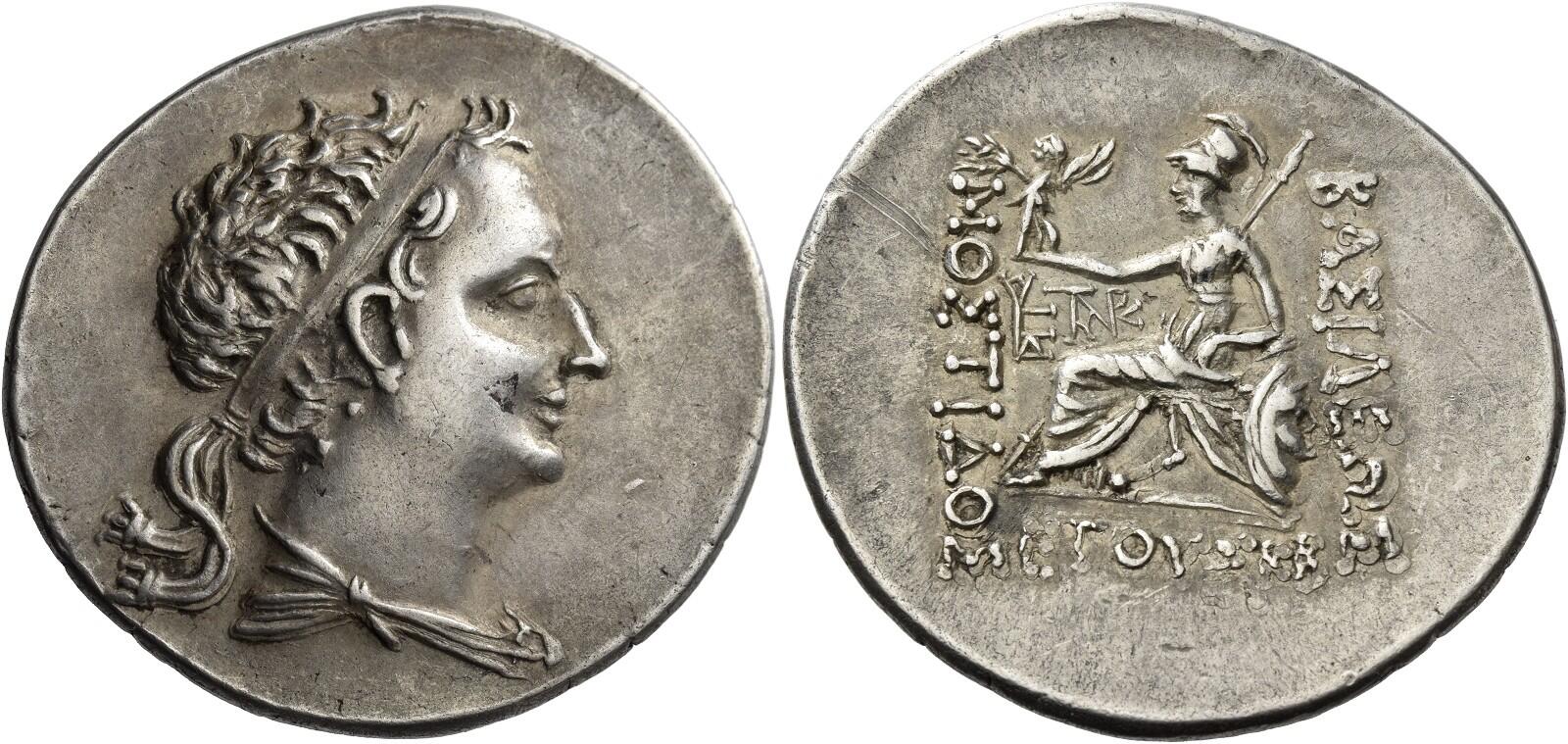Thrace (uncertain mint) (Mostis), silver, tetradrachms (Mostis/Athena) (110-85 BCE)
From SILVER
110 BCE - 85 BCE Silver 2,343 kg
Description
| ObverseInscription or printing placed on the obverse.: | Diademed and draped bust r. |
| ReverseInscription or printing placed on the reverse.: | ΒΑΣΙΛΕΩΣ MOΣΤΙΔΟΥ (Greek).Athena seated l., holding Nike and spear and resting l. elbow on shield, in inner l. field, monogram. In exergue, METOYΣ KB |
Mint and issuing power
| MintIdentifies the place of manufacture or issue of a numismatic object.: | Thrace (uncertain mint) | Ancient regionAncient region.: | Thrace | Modern countryModern country: Bulgaria | AuthorityIdentifies the issuing power. The authority can be "pretended" when the name or the portrait of X is on the coin but he/she was not the issuing power. It can also be "uncertain" when there is no mention of X on the coin but he/she was the issuing power according to the historical sources: | Lysimachus (Macedonian officer, diadochus and king, c. 360-281 BC), Mostis (king of the Caeni, 130-90 BC) |
Chronology
| FromIdentifies the initial date in a range assigned in a numismatic context. | 110 BCE | toIdentifies the final date in a range assigned in a numismatic context.. | 85 BCE | PeriodTime period of the numismatic object.: Hellenistic 323-30 BC |
Physical description
| MetalThe physical material (usually metal) from which an object is made.: | Silver |
Median weightMedian of the weights of numismatic objects (in grams). in grams | 16.50 | DenominationTerm indicating the value of a numismatic object. Examples: tetradrachm, chalkous, denarius.: | tetradrachm |
StandardStandard.: | Attic |
Image

H93 Mostis.jpg [1]
References
| Die study referencePublication of the study: | Callataÿ 1991b1Callataÿ 1991b, Callataÿ 1997a2Callataÿ 1997a, p. 258-259, Paunov 20143Paunov 2014, Paunov 20224Paunov 2022 | ||
| Coin series referenceReference to coin series study: | RQEMH5RQEMH, n° 93, HGC 3.26HGC 3.2, n° 1727 | ||
Obverse dies distribution
| FrequencyFrequency of specimen in distribution. ᵖ | Number of obversesNumber of obverse dies. ᵖ (o) | % (o) | Number of coinsNumber of coins. (n) | % (n) | Die nameName(s) of the die(s). |
| 1 | 1 | 14.29 | 1 | 1.41 | 4 |
| 2 | 1 | 14.29 | 2 | 2.82 | 5 |
| 6 | 1 | 14.29 | 6 | 8.45 | 1 |
| 9 | 1 | 14.29 | 9 | 12.68 | 2 |
| 11 | 1 | 14.29 | 11 | 15.49 | 3 |
| 19 | 1 | 14.29 | 19 | 26.76 | 7 |
| 23 | 1 | 14.29 | 23 | 32.39 | 7 |
| Total | 7 of 7 | 100.03 | 71 of 71 | 100 |
Reverse dies distribution
no distribution is available
Quantification
| Number of obversesNumber of obverse dies. ᵖ (o) | 7 | Number of singletons (o1)The number of singleton coins. ᵖ | 1 |
| Number of reverse diesNumber of reverse dies. (r) | 38 | Number of coinsNumber of coins. (n) | 71 |
| Coins per obverse dieNumber of coins per obverse die. (n/o) | 10.14 | Coins per reverse dieNumber of coins per reverse die. (n/r) | 1.87 |
| Reverse per obverse ratioRatio of obverse dies divided by reverse dies. (r/o) | 5.43 | Percentage of singletons (o1)number of coins (n) divided by the number of singletons (o1) ᵖ | 14.29 % |
| Original number of dies (O) (Carter 1983 formula)The estimation of the number of coins according to Carter 1983 ᵖ | 7.1 | Coins struck if 20,000 as average productivity per dieCoins made if the average productivity for obverses (according to Carter) is 20,000. ᵖ | 142,000 |
| Original number of dies (O) (Esty 2011 formula)The estimation of the number of coins according to the singleton formula in Esty 2011 ᵖ (O) | 7.77 | Survival rate if 20,000 as average productivity per dieSurvival rate if average productivity is 20,000. ᵖ | 0.00050 |
| Coverage (o = % of O) (Esty 1984 formula)Esty 1984 - coverage (% of O) ᵖ (o = % of O) | 98.59% | Die productivity if survival rate 1/2,000Average productivity if survival rate is 1/2,000. ᵖ | 20,000 |
| Weight of silver (in kg) if 20,000 coins per die (O = Carter formula)Carter 1983 * Median weight * 20000 (*10 if gold or electrum) ᵖ | 2,343 kg <br /> 2,343 kg | Die productivity if survival rate 1/5,000Average productivity if survival rate is 1/5,000. ᵖ | 50,000 |
Remarks
Most likely one single workstation Certainly military This is the revised and still unpublished die-study by Atanas Koychev (private information). Paunov 2014 (4 obv. for 20 coins); Paunov 2022 (4 obv. for 24 coins).